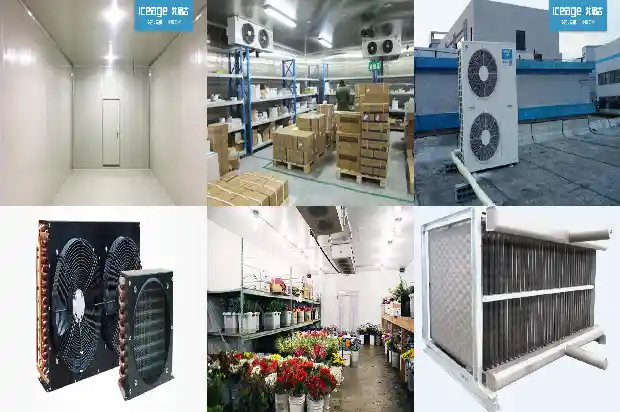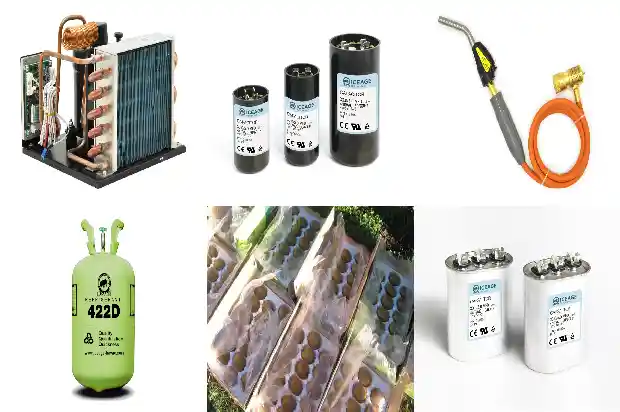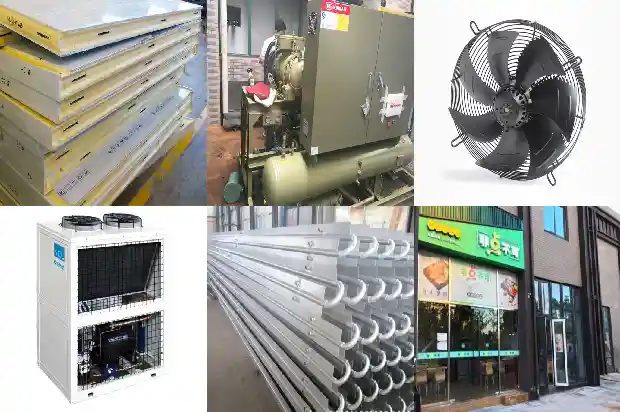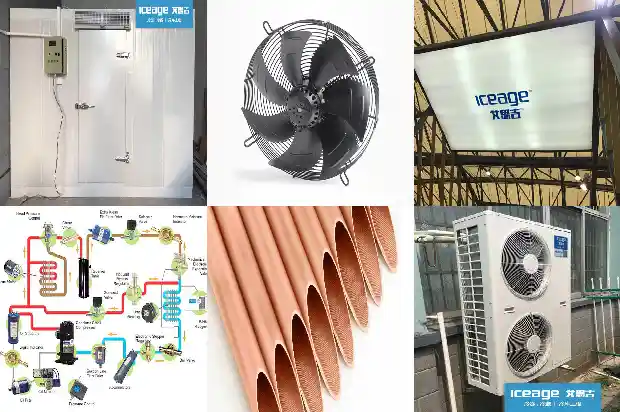Fin Spacing Design of Cooler and Several Knowledge Points of Defrosting in Cold Storage
2024-10-07
I. Selection of Fin Spacing for Fin-and-Tube Heat Exchanger of Air Cooler:
As a commonly used evaporator in refrigeration systems, the proper selection of an air cooler directly affects the efficiency of the refrigeration system. As we all know, air coolers will adopt different fin spacings according to different required ambient temperatures.
For the common air coolers we see, the fin spacings are 4mm, 4.5mm, 6-8mm, 10mm, 12mm, 16mm; there are also those with variable fin spacings at the front and back. A small fin spacing is suitable for high-temperature environments. The lower the temperature of the cold storage, the larger the required fin spacing. If the selection is incorrect, the fins will frost quickly and soon block the air passage. It will be difficult for the cold storage to cool down, and the efficiency of the compressor cannot be exerted, resulting in an increase in the power consumption of the refrigeration system.
For the selection of evaporator fin spacing, we can refer to the following principles:
For environments ranging from 0°C to 20°C, such as workshop air conditioning, cool storage, cold storage passageways, fresh-keeping storages, controlled atmosphere storages, and ripening storages, air coolers with a fin spacing of 4mm or 4.5mm should be selected;
For environments ranging from -16°C to -25°C, such as low-temperature frozen storage and low-temperature logistics storages, air coolers with a fin spacing of 6mm to 8mm should be selected;
For quick-freezing storages with temperatures ranging from -25°C to -35°C, air coolers with fin spacings of 10mm and 12mm are generally selected. If the humidity of the quick-frozen goods is high, an air cooler with variable fin spacing will be chosen. The fin spacing on the air inlet side can reach 16mm.
However, in some occasions, the fin spacing of the air cooler cannot be simply selected according to temperature. For example, in the rapid pre-cooling and acid removal of meat and vegetables, although the cold room temperature is generally set above 0°C, due to the high incoming goods temperature, fast cooling speed, and high humidity of the goods, if an air cooler with a fin spacing of 4mm or 4.5mm is selected again, it will be inappropriate. An air cooler with a fin spacing of 8mm or even 10mm must be used.
There are also fresh-keeping storages similar to those for storing fruits and vegetables such as garlic and apples. The suitable storage temperature is generally around -2°C.
As a commonly used evaporator in refrigeration systems, the proper selection of an air cooler directly affects the efficiency of the refrigeration system. As we all know, air coolers will adopt different fin spacings according to different required ambient temperatures.
For the common air coolers we see, the fin spacings are 4mm, 4.5mm, 6-8mm, 10mm, 12mm, 16mm; there are also those with variable fin spacings at the front and back. A small fin spacing is suitable for high-temperature environments. The lower the temperature of the cold storage, the larger the required fin spacing. If the selection is incorrect, the fins will frost quickly and soon block the air passage. It will be difficult for the cold storage to cool down, and the efficiency of the compressor cannot be exerted, resulting in an increase in the power consumption of the refrigeration system.
For the selection of evaporator fin spacing, we can refer to the following principles:
For environments ranging from 0°C to 20°C, such as workshop air conditioning, cool storage, cold storage passageways, fresh-keeping storages, controlled atmosphere storages, and ripening storages, air coolers with a fin spacing of 4mm or 4.5mm should be selected;
For environments ranging from -16°C to -25°C, such as low-temperature frozen storage and low-temperature logistics storages, air coolers with a fin spacing of 6mm to 8mm should be selected;
For quick-freezing storages with temperatures ranging from -25°C to -35°C, air coolers with fin spacings of 10mm and 12mm are generally selected. If the humidity of the quick-frozen goods is high, an air cooler with variable fin spacing will be chosen. The fin spacing on the air inlet side can reach 16mm.
However, in some occasions, the fin spacing of the air cooler cannot be simply selected according to temperature. For example, in the rapid pre-cooling and acid removal of meat and vegetables, although the cold room temperature is generally set above 0°C, due to the high incoming goods temperature, fast cooling speed, and high humidity of the goods, if an air cooler with a fin spacing of 4mm or 4.5mm is selected again, it will be inappropriate. An air cooler with a fin spacing of 8mm or even 10mm must be used.
There are also fresh-keeping storages similar to those for storing fruits and vegetables such as garlic and apples. The suitable storage temperature is generally around -2°C.

II. Impact of Frost Formation on the Refrigeration System:
When the refrigeration system of a cold storage is operating normally, the surface temperature of the evaporator is much lower than the dew point temperature of the air, and moisture in the air will precipitate and condense on the tube wall. If the tube wall temperature is lower than 0°C, the water dew will condense into frost. Frost formation is also the result of the normal operation of the refrigeration system, so a small amount of frost formation is allowed on the evaporator surface.
Due to the extremely low thermal conductivity of frost, which is one percent or even a few hundredths of that of metal, a frost layer forms a relatively large thermal resistance. Especially when the frost layer is thick, it is like insulation, making it difficult for the cold in the evaporator to be emitted, affecting the refrigeration effect of the evaporator, and ultimately making the cold storage unable to reach the required temperature.
At the same time, the evaporation of the refrigerant in the evaporator will also be weakened. Incompletely evaporated refrigerants may be sucked in by the compressor and cause liquid hammer accidents. Therefore, the frost layer must be removed; otherwise, the frost layer will become thicker and thicker, and the refrigeration effect will become worse and worse.
When the refrigeration system of a cold storage is operating normally, the surface temperature of the evaporator is much lower than the dew point temperature of the air, and moisture in the air will precipitate and condense on the tube wall. If the tube wall temperature is lower than 0°C, the water dew will condense into frost. Frost formation is also the result of the normal operation of the refrigeration system, so a small amount of frost formation is allowed on the evaporator surface.
Due to the extremely low thermal conductivity of frost, which is one percent or even a few hundredths of that of metal, a frost layer forms a relatively large thermal resistance. Especially when the frost layer is thick, it is like insulation, making it difficult for the cold in the evaporator to be emitted, affecting the refrigeration effect of the evaporator, and ultimately making the cold storage unable to reach the required temperature.
At the same time, the evaporation of the refrigerant in the evaporator will also be weakened. Incompletely evaporated refrigerants may be sucked in by the compressor and cause liquid hammer accidents. Therefore, the frost layer must be removed; otherwise, the frost layer will become thicker and thicker, and the refrigeration effect will become worse and worse.
III.
The frosting of the refrigeration evaporator in a cold storage should be comprehensively analyzed from multiple aspects. The design of the evaporator, the fin spacing of the evaporator, and the arrangement of pipelines should be optimized as a whole. The main reasons for severe frosting of the cold storage air cooler are as follows:

The frosting of the refrigeration evaporator in a cold storage should be comprehensively analyzed from multiple aspects. The design of the evaporator, the fin spacing of the evaporator, and the arrangement of pipelines should be optimized as a whole. The main reasons for severe frosting of the cold storage air cooler are as follows:
- Damage to the maintenance structure, moisture-proof and vapor barrier layer, and thermal insulation layer, resulting in a large amount of wet air outside entering the cold storage;
- The cold storage door is not tightly sealed, the door frame or door is deformed, and the sealing strip is aged, loses elasticity or is damaged;
- A large amount of fresh goods enter the cold storage;
- There is serious water-based operation in the cold storage;
- Frequent entry and exit of goods.
Usually, there are four most common defrosting methods for cold storage evaporators:
The first type: Manual defrosting
During the manual defrosting process, safety is the top priority. Do not damage the refrigeration equipment.
Most of the frost on the equipment falls off from the refrigeration equipment in a solid state, which has little impact on the internal temperature of the cold storage. The disadvantages are that the labor intensity is high, the labor time cost is relatively high, the manual defrosting coverage is incomplete, the defrosting is not thorough, and it is easy to damage the refrigeration equipment.
The second type: Water defrosting
As the name suggests, water is poured onto the surface of the evaporator. The temperature of the evaporator rises, forcing the frost adhering to the surface of the evaporator to melt. Water defrosting is carried out outside the evaporator. Therefore, during the water defrosting process, proper handling of water flow must be done to avoid affecting the normal use of refrigeration equipment and some items placed in the cold storage.
Water flushing defrosting is simple to operate and takes a short time. It is a very effective defrosting method. In a cold storage with a very low temperature, after repeated defrosting, if the water temperature is too low, it will affect the defrosting effect. If the frost is not flushed clean within the set time, after the air cooler works normally, the frost layer may turn into an ice layer, making the next defrosting more difficult.
The third type: Electric heating defrosting
Electric heating defrosting is for equipment that uses air fans for refrigeration in cold storages. Electric heating tubes or heating wires are installed in the upper, middle, and lower parts inside the fin of the refrigeration fan. The electric current's thermal effect is used to defrost the fan. This method can intelligently control defrosting through a microcomputer controller. By setting defrosting parameters, intelligent timing defrosting can be achieved, which can greatly reduce manual time and effort. The disadvantage is that electric heating defrosting will increase the power consumption of the cold storage to a certain extent, but the efficiency is very high.
The fourth type: Defrosting with hot working medium:
Defrosting with hot working medium uses the superheated refrigerant vapor with a relatively high temperature discharged from the compressor. After passing through the oil separator, it enters the evaporator. The evaporator is temporarily used as a condenser. The heat released when the hot working medium condenses is used to melt the frost layer on the surface of the evaporator.
At the same time, the originally accumulated refrigerant and lubricating oil in the evaporator are discharged into the defrosting drain barrel or low-pressure circulation barrel by means of pressurization or gravity of the hot working medium. When defrosting with hot gas, the load on the condenser is reduced, and the operation of the condenser can also save some electrical energy.
Related Articles
- Influence of Fin Spacing of Evaporator in Air Cooler on Frost Formation
- HVAC Design | Basics of Cooling Towers
- 【HVAC Design Summary】 - Free Cooling with Cooling Towers
- Precautions for Cold Storage Design
- Function and Working Principle of Subcooler
- Practical Knowledge on Freeze Protection of Air - conditioning Equipment
- Basic Knowledge of Valve - type Components in Refrigeration Systems (Technical Sharing)
- Basic Knowledge of Cooling Towers
- Knowledge, Installation and Maintenance of Cold Storage Systems
- Obscure Knowledge of Static Pressure, Dynamic Pressure, Latent Heat and Sensible Heat in the HVAC Industry
- Reference Points for Selection of Screw - type Chillers
- Introduction to Key Points of Compressor Grouping in Quick-freezing Cold Storage
- 4 Points on Causes of Water Leakage in Closed Cooling Towers
